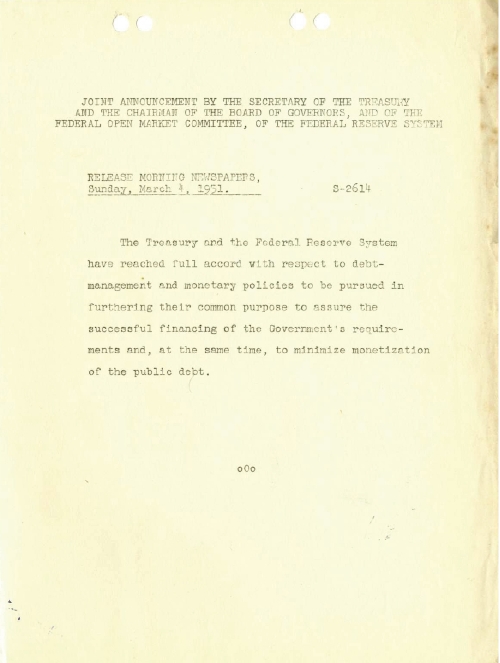To support the nation’s efforts during World War II, the Federal Reserve committed to maintaining a low interest rate peg at the request of the Department of the Treasury. The policy reduced financing costs and allowed the federal government to lower the cost of financing the war debt. However, maintaining the peg meant that the Fed gave up considerable control of its balance sheet. To maintain the low interest rate, the Fed was committed to buying large amounts of government securities, which increased the money supply.
During the war, higher income tax rates and wage and price controls were encouraged to combat inflation. The low rates continued after the war. Initially, aside from the period following removal of some wartime controls, inflation stayed fairly low and the economy was fairly stable. The Fed planned to adjust the rates in the future as necessary, but the Treasury did not agree. The government wanted to manage its massive war debt and simultaneously attempt to curb inflation. The Treasury chose to do so through consumer credit controls, tax increases, and price controls and opposed any of the Fed’s suggested changes in the securities rates.
In 1950, at the start of the Korean War, the Board of Governors became increasingly concerned about inflation. Both President Truman and Secretary of the Treasury Snyder continually communicated to the Federal Reserve that they wanted to maintain confidence in the market for government securities and that they opposed an increase in the interest rates.
The Treasury-Fed conflict came to a head in January 1951 after months of back-and-forth communications about the securities market. As the dispute became public through differing rate announcements, misleading press releases, and meeting leaks, the public’s confidence in the Treasury-Fed relationship waned. It was obvious that both parties needed to come to an agreement. Thus, after much deliberation, the March 4 Accord was reached and the Treasury and Federal Reserve were in agreement.
For documentation of this historical accord, check out FRASER’s Treasury-Federal Reserve Accord of 1951 timeline, as well as the subject “Treasury and Federal Reserve Accord, 1951.” In addition, the collection from “Meltzer’s History of the Federal Reserve – Primary Sources” provides documents cited in Dr. Allen H. Meltzer’s History of the Federal Reserve books. Volume 1 covers the years 1913-1951, including information on the Treasury-Federal Reserve Accord.

Joint Announcement by the Secretary of the Treasury and the Chairman of the Board of Governors, and of the Federal Open Market Committee of the Federal Reserve System, William McChesney Martin, Jr., Papers, Box 15, Folder 4; https://fraser.stlouisfed.org/archival/1341/item/472962


 @FedFRASER
@FedFRASER